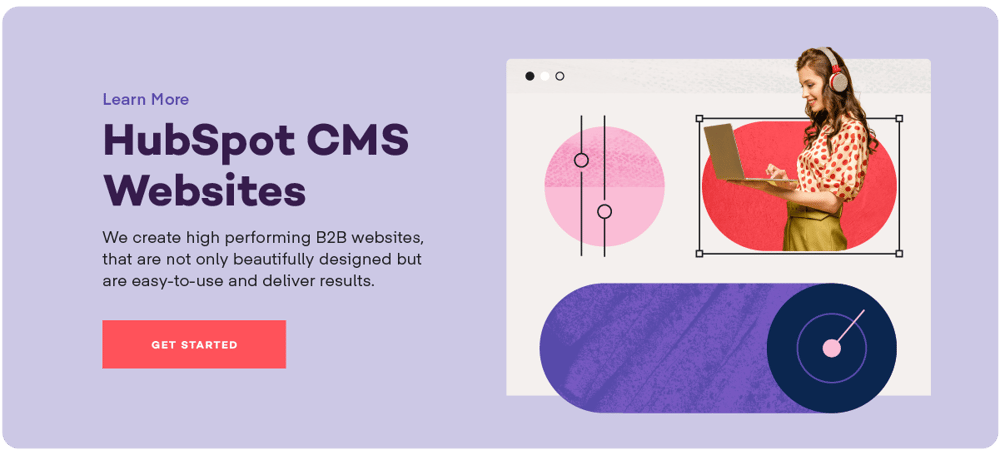In 2003, an American developer by the name of Matt Mullenweg launched a blogging tool called WordPress that would soon take over the internet – quite literally. Today it’s claimed that more than 40% of websites are powered by WordPress.
And I’m here to tell you that it’s the wrong tool for your website. Not only that, there’s a good chance that products like Craft, Umbraco and Silver Stripe that your local agency might be pitching to you aren’t the right choice for your B2B website either.
That’s because, just like software, everything is moving to the cloud. HubSpot, Webflow and SquareSpace – these are the new kids on the block. They are plug and play, don’t require technical knowledge to get setup and deliver results fast. But which is the best for your B2B website, and do you need an agency to help?
These are the things you need to know before you start building your website, or investing further in your existing one. This is your plan to deliver results:
- The tech stack matters, but it shouldn’t be a dev decision
Although the trend is changing, traditionally the decision around the content management system is deferred to whoever is building the website, often developers. However, it's important to step back and look at which will deliver the best results for your business, not just the initial build.
This is our job as marketing, growth and company leaders. We need to understand and navigate decisions around the key infrastructure that sits at the foundation of our businesses – and your website is a key piece.
The best place to start is to think about what needs to be tightly integrated with your website. For a B2B business, this is normally your CRM and marketing automation system. If you’re using HubSpot or are likely to move to it in the short-term future, this is the natural place to start.
It's always best to hire design and development teams that have built on the platform you’d like to use before. If they haven’t, look for other options.
- Metrics should be a predictor of business growth
What if I told you a targeted increase in website traffic of 10% would increase trial signups or meetings booked by 12% and in 3 months help you close 18% more deals. That would be useful information, right?
But to do this we need to know a few things. We need to know which channels can deliver outsized results (your go-to-market strategy is a fundamental underpinning for this), how to model the timing across the lifecycle and how to measure conversion at each point in this journey.
And we need sufficient traffic to draw meaningful conclusions, the people to draw them – and to connect the dots across marketing and sales. In fact, we need to know a whole lot more than a generic free CMS like WordPress will tell you. We need a marketing automation system and a revops mindset.
If you want your website to be a predictive indicator of growth then you need a layer of analytics, and the more tightly integrated the better. Aggregate data through Google Analytics may be enough for ecommerce sites, but for B2B websites you also need to be able to drill down to the individual.
- Iteration means continuous improvement, not ad hoc updates
The big question we posed at the beginning was which CMS would be the best fit for you. Unless there is a clearly identifiable reason not to choose a cloud-based option, this is the best starting point.
But there’s still a dizzying array of options, and you need to think about the stage of your growth and who is on the team:
- SquareSpace/Wix/Weebly - These are great options for those wanting to build primarily in house, and who are very early in their data driven journey. You can get something up and running fast, and it will look pretty good as well.
- Webflow – The leader of the no-code design category, Webflow fuses your CMS with sophisticated design tools to build compelling visual experiences. In their own words: “Your website should be a marketing asset, not an engineering challenge.”
- HubSpot – My personal favourite. Not only can you get started with an off the shelf template like Aamplify’s Growthplate, but you have a scalable, enterprise grade CMS that is so simple, anyone can use it. And, you have the tightest possible integration with HubSpot Marketing Sales and Operations.
You’ll probably need to work with an external agency to get your Launch Pad up and running but think about how you iterate after that. You need a platform that works equally well in house, so you can continuously improve while having the tools agencies need to build additional models and experiences as you need them.
So what does this mean for you and your company?
What works for one company, can be a bitter failure for another. But when you get it right, your website is more than a competitive advantage. It’s your secret weapon.
Building on the right tech stack from day one can save headaches later. You’re making a significant investment, so invest in the right people, skills and systems to get the job done right the first time.
Finally, don’t be afraid to innovate and experiment!
Need help building a new website or improving your existing website - check out our HubSpot website services.

Sometimes one conversation can ignite a spark that challenges your thinking.
Book a call with Aamplify, we're ready to light the fire.